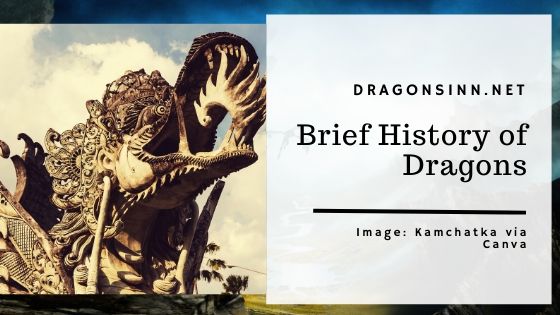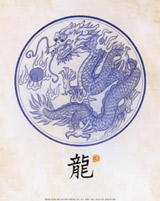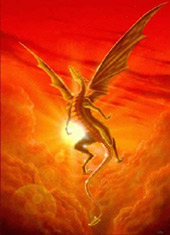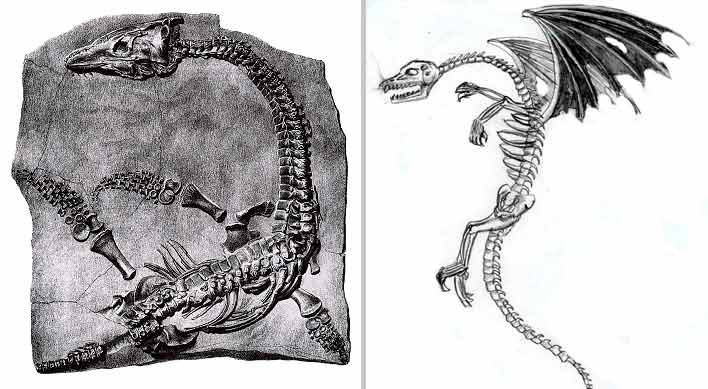Originally published 1 June 2008. Last updated 9 Jan 2021. Quick dragon facts on Chinese, Western, and Middle-Eastern dragons, with a very brief history.
Quick Dragon Facts
Table of Contents
Asian Dragons
Western Dragons
Middle-Eastern Dragons
Very Brief History
Chinese and Asian Dragons: Quick Facts
“Dragon Motif” | T.C. Chiu
1. Potent and prominent symbol of royalty and good luck.
2. Their breath is called “divine energy”.
3. Believed to rule the earth.
The four rulers:
· Celestial Dragon [t’ien-lung]
· Spiritual Dragon [shen-lung]
· Earth Dragon [ti-lung ]
· Underworld Dragon [fu-ts’ang lung]
4. Traditional Oriental dragon has 117 carp scales.
5. Bones and teeth were valued for their treatment of spirit disorders.
6. An Oriental dragon takes 3000 years to become a mature, real dragon.
7. All people in ancient China, including the Emperor, prostrated themselves before the image of a dragon.
8. The main difference between Eastern dragons: Chinese dragons have five claws, Japanese dragons three, and Korean dragons four.
9. The Japanese dragon Ryu, is a descendant of a primitive three-toed variety of Chinese dragon.
10. Yong is the most powerful Korean dragon. It protects the sky.
Learn more about the history of Chinese dragons and famous Chinese dragons.
Western Dragon Facts
“The Glory of the Golden Dragon”
by Steve Simmons | art directed by Andrew Bill
© Holland Studio Craft Ltd.
1. Traditionally, a symbol of evil.
2. Often depicted with a bulky, definite lizard-shape.
3. Notoriously solitary.
4. The snake was at the core of Western dragon mythology.
5. Most dragons encountered in Europe were killed in a great battle [often involving valiant knights, heroes, and the so-fair maidens in distress].
6. The Peluda was an amphibious French dragon that was also known as the “shaggy beast”.
7. The word dragon can be traced to a Greek word meaning “sharp-sighted one”.
8. Gozon, a Mediterranean hero, had the words “Here lies the Dragon Slayer” on his tomb. It is said to have been the only tomb with the inscription.
9. The Celtic word Pendragon means “chief”.
10. Nidhogg, from Norse mythology, was destined to survive even the end of the world.
Learn more about the history of Western dragons and famous Western dragons.
Middle Eastern Dragon Facts
Hittite seal from 2500 B.C showing a dragon-slayer
1. Many were sea creatures that embodied the threat of chaos.
2. Tiamat and Apsu were closely regarded as being both sea serpents and oceans.
3. The slaying of Tiamat created the world we know today.
4. Ra, the sun god, had to voyage through the underworld every night. Apep would be waiting to attack.
5. One of the most famous Egyptian dragons could be Uraeus, found on the royal headdresses and crowns.
6. The Hittites recite the Illuyankas myth every New Year’s Day.
7. The Serpent in the Garden of Eden is frequently portrayed with the face of Lilith.
8. Dragons made appropriate emblems for the stars mapped by Arabic astronomers.
9. The Ouroboros dragon perpetually has its tail in its mouth.
10. Marduk started off as a god of fertility, but eventually became the chief god of Babylon.
Learn more about the history of Middle Eastern dragons and famous Middle Eastern dragons.
A Brief History of Dragons
A very brief history of dragons. Transferred from the old website.
Expanding this post is on my to-do list.
Thanks to Sam Payton for suggesting this page’s construction many years ago.
The Universal Concept in Ancient Cultures
Dragon history is almost universal throughout the world’s ancient cultures. Societies throughout the world have records of the dragon. Might this point to the witnessing of these creatures during their lifetimes?
Dragon History & Dinosaurs
The dragons of legend are much like the great reptiles (dinosaurs), which inhabited the earth long before man is supposed to have appeared on earth.
Left image: Pleiosaur fossil at Berkeley.
Right image: Bone Dragon © Emily Elizabeth Bradford.
Paleontology (the earth science that studies fossils) is relatively new. The concept of dinosaurs (giant lizards) only surfaced in its present form about 200 years ago. Before that, anyone who found a large fossilized bone assumed it came from an elephant, dragon or giant. “Science” was not attached to these finds.
In 1842, the English scientist Richard Owens suggested that the group of “newly discovered” animals be called “dinosaurs,” which he defined as “fearfully-great lizards.”
Dragon Brief History: An Overview of the Evidence
Where do the accounts of dragon history originate from? One can start with the Bible, the most widely published book in history. The word “dragon” in the Bible is used throughout the Old Testament, and most directly translates as “sea or land monsters.”
Dragon accounts from China, Europe, the Middle East, and ancient Latin America share similar accounts of dragons. Some cultures revered these creatures. In other cultures, it was a great honor to slay these creatures. Famous legends with this concept include those of Gilgamesh, Fafnir, and Beowulf.
Dragon history is revealed on numerous objects of ancient art around the world. They are featured on Babylonian landmarks, Roman mosaics, Asian pottery and royal robes, Egyptian shrouds and seals, Peruvian burial stones, Mayan sculptures, Aboriginal and Native American petroglyphs (carved rock drawings). That’s an impressive and astounding number of cultures.
References:
Knox Wilson, “Dragon”, The World Book Encyclopedia, Vol. 5,
1973, pg. 265.)
Dragon History – Ancient Accounts:
http://www.allaboutcreation.org/dragon-history.htm





